All about Pie Crust!
Ah November! The month where autumnal vibes are aplenty, and the holiday spirit makes its first appearance. A time to slow down and relish the tastes and colors of this beautiful, fleeting season. The arrival of November also means Thanksgiving in the USA, and Thanksgiving screams pie!
I didn’t bake often growing up. As I have gotten older, I have realized that baking makes me feel grounded and present. The acts of baking and cooking are unique in that they engage all the senses. Making a pie can be a delightfully immersive creative experience. One of the easiest things to make from scratch is a pie crust, as it requires only a few easy ingredients. You can make it ahead of time and freeze (which I highly recommend).
Lets discuss ingredients! Fat. Flour. Water. Dash of salt for flavor. I add a sprinkling of sugar, also for flavor. Simple.
The choice of filling may seem like the biggest factor when it comes to making a pie, but the fat used also greatly affects the taste and texture of said pie. The two most common fat choices for pies these days are shortening and butter. The purpose of fat in pie dough is to separate the flour and the water, to create air pockets. The longer the fat stays there, the more air pockets are created, and the flakier the crust.
Another factor in play is the formation of gluten strands. Unlike bread dough, the forming of gluten is not ideal when making pie dough. Think about the way a shortbread cookie instantly melts in your mouth compared to a slice of bread that is chewy and soft. The difference lies in the formation of gluten strands. Shortening and butter have their pro’s and con’s when it comes to pie crusts. More on both below.
Let’s talk shortening. What is shortening, anyway? It is a fat that is solid at room temperature. It first gained popularity in the 1950s, it makes pie crust extra flaky. The crust also holds its shape better in the oven. This is especially helpful when making pies with decorative shapes and cutouts resting on the filling. Great choice especially if you want your pie to look aesthetically pleasing. The drawback is that it leaves much to be desired on the on flavor front when compared to its competitor, good old-fashioned butter.
My personal favorite is an all butter crust (recipe below). the flavor is simply irresistible! For people like me who make and eat pie only once a year, flavor takes precedence over the look. Butter yields a tender flaky crust as well, just not as flaky as one made with shortening.
Here is a recipe for easy, all-butter pie crust. Happy pie making!
Easy Pie Crust
2.5 cups (350 grams) All purpose flour
1 cup/2 sticks (226 grams) unsalted butter, chilled and cut into 1/4 inch cubes
1 tsp (5 grams) granulated sugar
1/2 tsp salt
1/4 to 1/2 cup (60 to 80 ml) ice water
Add the flour, salt, and sugar to a food processor, and pulse until combined. Add the butter and pulse, using the pulse button, until the mixture forms coarse crumbs. Pour 1/4 cup (60 ml) of ice water slowly, until the dough starts to clump together when pinched (you do not want a solid doughball). Add more water, only if necessary.
Tip the dough out onto a clean work surface and gather it into a ball (DO NOT KNEAD). Divide into two equal pieces, flatten each piece into a 5-6 inch disk to make it easier to roll. Wrap tightly with plastic wrap, and refrigerate until firm enough to roll (30-60 minutes), or freeze for up to a month.
